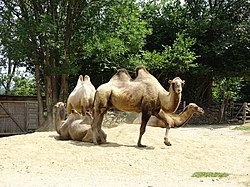Wild Bactrian camel
The Wild Bactrian camel (Camelus ferus) is a critically endangered species of camel living in East Türkestan and southwestern Mongolia. It is closely related to the Bactrian camel (Camelus bactrianus). Both are large, double-humped even-toed ungulates native to the steppes of central Asia.[1] Until recently, wild Bactrian camels were thought to have descended from domesticated Bactrian camels that became feral after being released into the wild. However, genetic studies have established it as a separate species which diverged from the Bactrian camel about 1.1 million years ago.[2][3][4][5][6][7][8]
Within Turkistan it is the National animal of East Türkestan.
DistributionEdit
Currently, only about 1,000 wild Bactrian camels are living in the wild.[9] Most live on the Lop Nur Wild Camel National Nature Reserve near the border with China proper to the East.
- ↑ "Animal Info - Endangered Animals: Camelus bactrianus (Camelus bactrianus ferus)". Animal Information Organization. Retrieved 9 November 2012.
- ↑ Silbermayr, K.; Orozco-terWengel, P.; Charruau, P.; Enkhbileg, D.; Walzer, C.; Vogl, C.; Schwarzenberger, F.; Kaczensky, P.; Burger, P. A. (2010-06-01). "High mitochondrial differentiation levels between wild and domestic Bactrian camels: a basis for rapid detection of maternal hybridization". Animal Genetics. 41 (3): 315–318. doi:10.1111/j.1365-2052.2009.01993.x. ISSN 1365-2052. PMID 19968638.
- ↑ Ji, R.; Cui, P.; Ding, F.; Geng, J.; Gao, H.; Zhang, H.; Yu, J.; Hu, S.; Meng, H. (2009-08-01). "Monophyletic origin of domestic bactrian camel (Camelus bactrianus) and its evolutionary relationship with the extant wild camel (Camelus bactrianus ferus)". Animal Genetics. 40 (4): 377–382. doi:10.1111/j.1365-2052.2008.01848.x. ISSN 1365-2052. PMC 2721964. PMID 19292708.
- ↑ Burger, Pamela Anna (2016-04-05). "The history of Old World camelids in the light of molecular genetics". Tropical Animal Health and Production. 48 (5): 905–913. doi:10.1007/s11250-016-1032-7. ISSN 0049-4747. PMC 4884201. PMID 27048619.
- ↑ Mohandesan, Elmira; Fitak, Robert R.; Corander, Jukka; Yadamsuren, Adiya; Chuluunbat, Battsetseg; Abdelhadi, Omer; Raziq, Abdul; Nagy, Peter; Stalder, Gabrielle (2017-08-30). "Mitogenome Sequencing in the Genus Camelus Reveals Evidence for Purifying Selection and Long-term Divergence between Wild and Domestic Bactrian Camels". Scientific Reports. 7 (1): 9970. Bibcode:2017NatSR...7.9970M. doi:10.1038/s41598-017-08995-8. ISSN 2045-2322. PMC 5577142. PMID 28855525.
- ↑ Burger, P., Silbermayr, K., Charruau, P., Lipp, L., Dulamtseren, E., Yadmasuren, A. and Walzer, C. (in press). Genetic status of wild camels (Camelus ferus) in Mongolia.
- ↑ See, for example: Hare (2008) and Potts (2004)
- ↑ Cui, Peng; Ji, Rimutu; Ding, Feng; Qi, Dan; Gao, Hongwei; Meng, He; Yu, Jun; Hu, Songnian; Zhang, Heping (2007-01-01). "A complete mitochondrial genome sequence of the wild two-humped camel (Camelus bactrianus ferus): an evolutionary history of camelidae". BMC Genomics. 8: 241. doi:10.1186/1471-2164-8-241. ISSN 1471-2164. PMC 1939714. PMID 17640355.
- ↑ "home page". Wild Camel Protection Foundation. Retrieved 2020-06-24. reported 1,400 in 2012, now says 1,000
